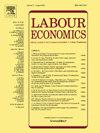Work less but stay longer — Mature worker responses to a flexibility reform
IF 2.6
2区 经济学
Q2 ECONOMICS
引用次数: 0
Abstract
Many consider that reducing the eligibility age for pension benefits will discourage labour supply among mature workers. This paper analyses a recent Norwegian pension reform that effectively lowered the eligibility age for retirement for some workers from 67 to 62, and we find that the above proposition might not be true. For these workers, the option of flexibly claiming from age 62 is introduced while the expected present value of benefits is held constant through actuarial adjustment of the periodic pension payments. This reform provides us with a unique opportunity to isolate the impact of increased flexibility on labour supply. We employ an event-study difference-in-difference approach to study the labour supply response (measured by number of weekly working hours as well as labour earnings) on the intensive and extensive margin. For those aged from 62 to 66, the reform leads to an increase in the labour supply at the extensive margin of 1.3 percentage points with a reduction in inflow to disability, and a decrease in the intensive margin of labour supply as measured by weekly working hours. In addition, a shift in the distribution of labour earnings further supports the finding that there is a decrease in the intensive margin of labour supply. Our findings thus suggest that increased pension flexibility could promote a gradual exit from the labour market, allowing for greater individual choice and positive welfare effects. This flexibility could also be an important component of broader pension reform.
少工作,长时间工作——成熟员工对灵活性改革的反应
许多人认为,降低领取养老金的资格年龄将阻碍成年工人的劳动力供应。本文分析了挪威最近的养老金改革,该改革有效地将一些工人的退休年龄从67岁降低到62岁,我们发现上述命题可能不成立。对于这些工人,从62岁开始实行灵活申索的选择,而通过定期养恤金支付的精算调整,保持福利的预期现值不变。这一改革为我们提供了一个独特的机会,以隔离增加灵活性对劳动力供应的影响。我们采用事件-研究差异的方法来研究劳动力供给对集约化和粗放化边际的响应(通过每周工作小时数和劳动收入来衡量)。对于那些年龄在62岁至66岁之间的人来说,改革导致劳动力供应增加了1.3个百分点,减少了残疾人的流入,并减少了以每周工作时间衡量的劳动力供应密集度。此外,劳动收入分配的变化进一步支持了劳动供给密集边际减少的结论。因此,我们的研究结果表明,提高养老金的灵活性可以促进劳动力市场的逐步退出,允许更大的个人选择和积极的福利效应。这种灵活性也可以成为更广泛的养老金改革的重要组成部分。
本文章由计算机程序翻译,如有差异,请以英文原文为准。
求助全文
约1分钟内获得全文
求助全文
来源期刊

Labour Economics
ECONOMICS-
CiteScore
3.60
自引率
8.30%
发文量
142
期刊介绍:
Labour Economics is devoted to publishing research in the field of labour economics both on the microeconomic and on the macroeconomic level, in a balanced mix of theory, empirical testing and policy applications. It gives due recognition to analysis and explanation of institutional arrangements of national labour markets and the impact of these institutions on labour market outcomes.
 求助内容:
求助内容: 应助结果提醒方式:
应助结果提醒方式:


